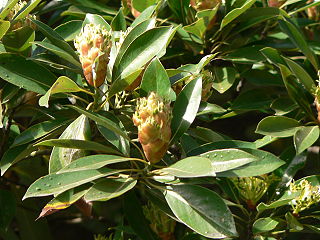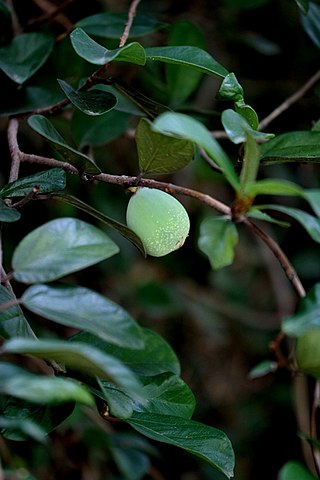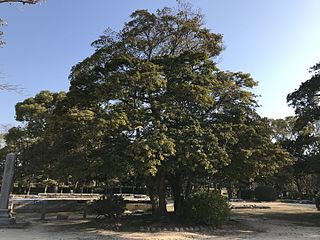Galls or cecidia are a kind of swelling growth on the external tissues of plants. Plant galls are abnormal outgrowths of plant tissues, similar to benign tumors or warts in animals. They can be caused by various parasites, from viruses, fungi and bacteria, to other plants, insects and mites. Plant galls are often highly organized structures so that the cause of the gall can often be determined without the actual agent being identified. This applies particularly to insect and mite plant galls. The study of plant galls is known as cecidology.

Lauraceae, or the laurels, is a plant family that includes the true laurel and its closest relatives. This family comprises about 2850 known species in about 45 genera worldwide. They are dicotyledons, and occur mainly in warm temperate and tropical regions, especially Southeast Asia and South America. Many are aromatic evergreen trees or shrubs, but some, such as Sassafras, are deciduous, or include both deciduous and evergreen trees and shrubs, especially in tropical and temperate climates. The genus Cassytha is unique in the Lauraceae in that its members are parasitic vines. Most laurels are highly poisonous.

Casuarina, also known as she-oak, Australian pine and native pine, is a genus of flowering plants in the family Casuarinaceae, and is native to Australia, the Indian subcontinent, Southeast Asia, islands of the western Pacific Ocean, and eastern Africa.

Ambrosia artemisiifolia, with the common names common ragweed, annual ragweed, and low ragweed, is a species of the genus Ambrosia native to regions of the Americas.

Machilus is a genus of flowering plants in the family Lauraceae. It is found in temperate, subtropical, and tropical forest, occurring in China, Korea, Japan, Taiwan, Indochina, the Indian subcontinent, Malaysia, Indonesia, and the Philippines. It is sometimes included in the genus Persea, and currently includes about 100 species.

Cecidomyiidae is a family of flies known as gall midges or gall gnats. As the name implies, the larvae of most gall midges feed within plant tissue, creating abnormal plant growths called galls. Cecidomyiidae are very fragile small insects usually only 2–3 mm (0.079–0.118 in) in length; many are less than 1 mm (0.039 in) long. They are characterised by hairy wings, unusual in the order Diptera, and have long antennae. Some Cecidomyiids are also known for the strange phenomenon of paedogenesis in which the larval stage reproduces without maturing first. In some species, the daughter larvae consume the mother, while in others, reproduction occurs later on in the egg or pupa.

Ficus pumila var. awkeotsang, also known as the jelly fig, aiyu, or ai-yu, is a variety of Ficus pumila, and a member of the fig family Moraceae, native to Taiwan. The plant is known for its use in making aiyu jelly.

Creosote gall midges are a species of gall-inducing flies in the Asphondylia auripila group. This group consists of 15 closely related species of flies which inhabit creosote bush sensu lato. They have partitioned the plant ecologically with different gall midge species inhabiting the leaves, stems, buds, and flowers of creosote bush. Each species induces a uniquely shaped gall but the insects are otherwise morphologically very similar and very difficult to tell apart.
Orseolia oryzae, also called the Asian rice gall midge, is a species of small fly in the family Cecidomyiidae. It is a major insect pest of rice. The damage to the crop is done by the larvae which form galls commonly known as "silver shoots" or "onion shoots". The rice plant is stunted and the seed heads fail to develop.

Elaeocarpus sylvestris, the woodland elaeocarpus, is a tree species in the genus Elaeocarpus.
Daphnephila truncicola is a species of gall midges first associated with stem galls on Lauraceae species, particularly Machilus thunbergii in Taiwan. Based on analysis on sequences of the mitochondrial cytochrome c oxidase subunit I, it has been suggested that in this genus, the stem-galling habit is a more ancestral state as opposed to the leaf-galling habit. This genus appears to have originated tropically and dispersed to Japan through Taiwan.
Daphnephila sueyenae is a species of gall midges first associated with leaf galls on Lauraceae species, particularly Machilus thunbergii in Taiwan. Based on analysis on sequences of the mitochondrial cytochrome c oxidase subunit I, it has been suggested that in this genus, the stem-galling habit is a more ancestral state as opposed to the leaf-galling habit. This genus appears to have originated tropically and dispersed to Japan through Taiwan.
Daphnephila ornithocephala is a species of gall midge first associated with leaf galls on Lauraceae species, particularly Machilus thunbergii in Taiwan. Based on analysis on sequences of the mitochondrial cytochrome c oxidase subunit I, it has been suggested that in this genus, the stem-galling habit is a more ancestral state as opposed to the leaf-galling habit. This genus appears to have originated tropically and dispersed to Japan through Taiwan.
Daphnephila stenocalia is a species of gall midges first associated with leaf galls on Lauraceae species, particularly Machilus thunbergii in Taiwan. Based on analysis on sequences of the mitochondrial cytochrome c oxidase subunit I, it has been suggested that in this genus, the stem-galling habit is a more ancestral state as opposed to the leaf-galling habit. This genus appears to have originated tropically and dispersed to Japan through Taiwan.

Asphondyliini is a tribe of gall midges in the family Cecidomyiidae. There are about six genera and at least 100 described species in Asphondyliini.
Daphnephila is a genus of gall midge that appears in the Palearctic and Oriental biogeographic realms. Daphnephila species create leaf and stem galls on species of laurel plants, particularly in Machilus. Based on analysis on sequences of the mitochondrial cytochrome c oxidase subunit I, it has been suggested that in this genus, the stem-galling habit is a more ancestral state as opposed to the leaf-galling habit.
Wiebesia pumilae is a fig wasp species in Genus Wiebesia, Family Agaonidae. W. pumilae is the pollinator of Ficus pumila var. awkeotsang and Ficus pumila var. pumila. The scientific name was first published as Blastophaga pumilae in 1967 by Hill.

Anantanarayanan Raman is a Professor of Ecology with Charles Sturt University, NSW and a scientist with CSIRO, Australia.

Machilus thunbergii, the Japanese bay tree, red machilus, or tabunoki, is a widespread species of flowering plant in the family Lauraceae. It is native to Vietnam, Taiwan, southeast and north-central China, the Korean Peninsula, and Japan. A sturdy evergreen tree, usually 10–15 m (30–50 ft) tall, and reaching 20 m (70 ft), it is used for timber, and as a street tree. Its bark is the source of makko, a powder used to make a mosquito‑repelling incense. It prefers coastal areas, and can handle saline soil.
Pseudopestalotiopsis is a genus of plant pathogens in the family Sporocadaceae.










